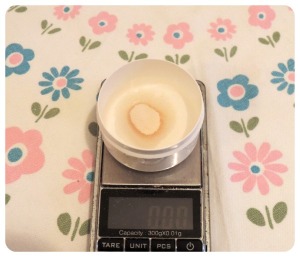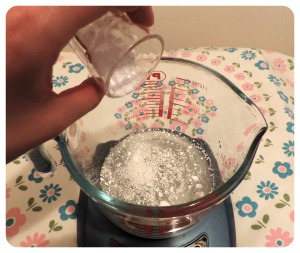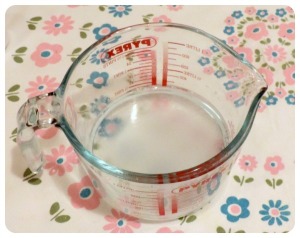Here I will be more specific about formulating a lotion.
As I already said the PHASE A, also called “water phase” or “heated water phase”, is the first step to the making of our lotion/cream.
It is mostly heated even if actually it all depends on the other ingredients we are using: the point is that most emulsifiers need to be heated to 70°C and to emulsify it is needed that waters and fats, read “phase A and phase B”, are also both heated up to this temperature. So usually phase A is heated in a double boiler up to 70°C at the same time of phase B.
What does the phase A contain?
– WATER.
Any lotion should contain at least 70% water (there is a post on water HERE).
You could also use herbal hydrosols (which doesn’t mean “herbal infusion”) but anyway bear in mind that these waters are mostly expensive and do not have so great properties (IMO better you save your money to buy active ingredients 😉 ).
– GLYCERIN
Glycerin is highly hygroscopic, which means that has the ability to attract and hold water molecules very very tight 🙂
This will be the “magic ingredient” which won’t let your lotions become dry after few days you opened them but will actually keep them moisturized.
As you can imagine, the fact that it is so highly hygroscopic is not only a “plus”: if, for example, you add too much glycerin to your face cream you can be sure that after a couple of hours your face will look bit shiny/oily.
So, the percentage of use is 1.5-5% (1.5% should be the minimum, used for example in creams for oily skin; 2-3.5% is for normal to dry skin; 4-5% is for body lotions).
– GELLING AGENTS
Gelling agents help the lotion to be slightly more firm but mostly they are used to keep the emulsion more stable (only with a small small number of emulsifiers you should avoid using them).
There are many gelling agents, I am going to speak of those I have used:
– xanthan gum, there is of two kinds: normal and transparent grade (which gives a transparent gel): it gives a very slimy gel which doesn’t have the best consistency but it is a great gelling agent which does not “melt down” even if you add a high percentage of “salts” (just keep reading 🙂 ). If you use too much it creates a “film” in your skin and it makes you sweat.
If it is the only gelling agent you have, you could use it at 0.2-0.35%; the best, however, would be to use it as a stabilizer of another gelling agent (the next one for example).
How to use it: I usually take the phase A becher and add the glycerin, then add the xanthan gum and mix with a spatula. When it looks dispersed I add the water little at a time. If you incorporate air while mixing just let the gel rest and the bubbles will go.
Here is a picture of glycerin with xanthan gum just poured on top:

– carbopol ultrez 21, there are tons of “carbopol…” but I am going to speak of what I know better: I haven’t tried the others well enough to make up my mind about them; what I have read is that carbomers create gels which are slightly difficult to keep stable. This “carbopol ultrez 21” is not too difficult to use and, if you follow some rules, it will give great results.
The bad part is that it is stable only at pH 6: if you rise the pH too much everything will be spoiled and there is nothing you can do to save it. Another bad part is that if you add salts to the lotion, the gel melts down and everything is ruined. When I say “salts” I am not referring to cooking salts (only 🙂 ) but I am chemically speaking, so for example you shouldn’t add too much sodium hyaluronate (hyaluronic acid? 😉 ).
But so why should we use something which could give problems in the formula? Simple: it makes a good gel, it doesn’t give other problems like the white “trail” (? not sure… if somebody can help me with my English I will be glad 🙂 )… I am talking about one thing which happens with certain creams: when you spread it, it doesn’t absorb easily and it actually creates a white “trail”, nothing terrible but still we want to avoid it 🙂 . Anyway, I was saying: this ultrez 21 makes a good gel, good consistency in the cream, good finish… so what to do? Simple! We try to help it to be stable by not leaving it alone!
If you want to leave it alone you can use it from 0.5 to 1%, if you use it with xanthan gum (which is a good stabilizer) then I usually do: 0.2% xanthan gum and 0.3-0.5% ultrez 21.
How to make the gel: if you use it alone just measure the glycerin, add the water, measure separately the ultrez 21 and pour it on top of the water without mixing with a spoon.
Here is a picture:

After a short time it will hydrate and it will “enter” the water: notice that it won’t become a gel immediately but it will rather float inside the water (therefore not making it transparent, like in this picture):

At this point you can use an immersion mixer paying attention to not incorporate air, just to make it hydrate more. The water will still be liquid at this time because this carbomer lowers the pH and therefore, not being pH6 yet, it will still be liquid. Don’t worry: add one by one drops of a solution 1:9 of sodium hydroxide and water (one part sodium and 9 parts water) and you will see the water become a gel just in front of you 🙂 . If, instead, you are going to use it together with the xanthan gum then you need to separate the two gels in the beginning: use the xanthan gum as I wrote above but do not add all the water there; in another becher pour the remaining water, add the ultrez 21, wait, mix with the immersion mixer and, before adjusting the pH to 6, mix the “xanthan gel” and the “ultrez 21 water” together. Only now adjust the pH :).
– hydroxiethyl cellulose, there are different kinds of this gelling agent, so read the technical card to know at which percentage it should be used. Anyway, according to its density, it can be used from 1% up to 5% (if you are unsure which kind you bought, you can ask your supplier or you can use a middle %: from 1.5 to 2.5% but bear in mind that if you use too much it really becomes too thick). The good thing of this hydroxyethyl cellulose is that it doesn’t have any problem with other ingredients and the gel is not of bad quality either (I don’t love it, but that’s my taste 🙂 also with making lotions you should always try and make up your mind on what you like and what you don’t 🙂 ). The big difference from the other two gelling agents, however, is that it works at 70°C only, so it must be heated. I read different ways of using it, I personally use it this way: I warm up the water in a double boiler, I wait that it reaches 70°C and then pour it while stirring with a spoon (the best would be to have a very small mixer that keeps the water moving while you pour… well, I don’t have it 🙂 ). It becomes a little lumpy (I hope this is the correct word 🙂 ) so after a while I use my immersion mixer paying attention that I don’t incorporate (too much) air. That’s it.
I hope I didn’t forget too much 🙂 Have a good day! 🙂
If you want to add something or explain something better, please share your knowledge 😀
(Sources)

Exceptional post however I was wanting to know if
you could write a litte more on this topic?
I’d be very grateful if you could elaborate a little bit more. Bless you!
LikeLike
Great post! Keep going. I definitely follow you now. 🙂 Thank you.
LikeLike
How can I use ml or cups instead of %
LikeLike
Great post! I definitely follow you now. Thank you.
LikeLike
Hi. When can or how can some one add this in base cream lotion.
Thanks
LikeLike
Hi. When can or how can some one add this in base cream lotion.
Thanks.
LikeLike
Hello Yommex.
I don’t understand: you want to add the phase A to a base cream lotion?
Or you want to formulate the Phase A for a base cream lotion?
LikeLike
Hi– quick question. For the Hydroxyethyl Cellulose, do you heat the glycerin with the water and then add it, or do you heat the water, add the hydroxyethyl cellulose, then add the glycerin after?
LikeLike
You can do either way. I believe, however, that I always added the glycerin first 🙂
LikeLike
If I use Hydroxyethyl cellulose, that mean I have to heat twice? First for hydroxyethyl cellulose in phase A, second for mix Phase A to phase B together? Thank you in advance.
LikeLike
Well if you prepare and heat phase B at the same time, after you adf hydroxyethylcellulose to phase A you can mix A and B soon afterwards 🙂
LikeLike
Thanks
LikeLiked by 1 person
Thanks for the great work
LikeLike